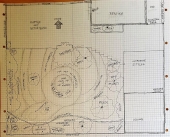I've been doing some research on how I can minimize water use and moisture loss from evaporation when designing an annual vegetable area as part of the high-traffic zone in part of a permaculture system and In the process I learned about the role of disturbances caused by animals in the ecology of annual vegetables.
It seems that most crop-wild relatives of annual vegetables thrive in disturbed area created by animals in nature. These are primarily wild boar and wisent wallows in Europe and historically buffalo wallows in North America. I've been reading a blog by Natalie Mueller where she links the habitat of the loat Eastern Agricultural Complex crops with buffalo wallows found in the eastern prairies. These paraboloid circles in the dirt are created by the dust-bathing of American bison in the same area over a long period of time and the depressions vary from two to three feet deep. Once a herd abandons a wallow, these disturbed depressions in the ground can create pockets of land where annual pioneer plants can colonize from the surrounding land, including sunflowers, goosefoot, maygrass, and marsh elder. Here is the article where Natalie explains this phenomenon on her blog: (
https://ngmueller.net/2019/11/06/lost-crops-where-the-buffalo-roam/)
In case of hyperlink rot, here is another YouTube video explaining buffalo wallows:
At the same time, I have also been researching the startup costs required if I want to start a market garden for selling produce and I've been intimidated by the cost of using drip irrigation so I wanted to find a cheaper solution for keeping an area of annual vegetables at maximum potential production without expensing tubing and pipes. If the crop wild relatives of annual vegetables seem to prefer disturbed depressions in the ground created by larger animals, then there must be some way to use this information to the advantage of growing annual vegetables in a permaculture system. Should I be designing vegetable beds as sunken parabolic depressions? This seems to remind me of irrigation techniques used in the desert southwest US to conserve water by planting corn in shallow depressions in the soil. Perhaps a three sisters bed could be modified around the shape of a buffalo wallow with more water-hungry plants be planted in the center and less water hungry plants being planted on the edges of the bed.
Mandrake...takes on and holds the influence
of the devil more than other herbs because of its similarity
to a human. Whence, also, a person’s desires, whether good
or evil, are stirred up through it...
-Hildegard of Bingen, Physica










